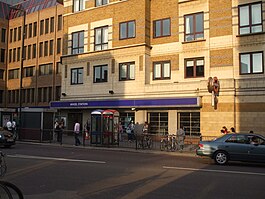
Back أنجل (محطة مترو أنفاق لندن) Arabic Angel (stanice metra v Londýně) Czech Angel Station Danish Angel (London Underground) German ایستگاه متروی انجل Persian Angelin metroasema Finnish Angel (métro de Londres) French 安卓站 GAN Angel metróállomás Hungarian Angel (metropolitana di Londra) Italian
| Angel | |
|---|---|
 Entrance of the post-1992 Angel station on Islington High Street. The building above has since been demolished. | |
| Location | Angel |
| Local authority | London Borough of Islington |
| Managed by | London Underground |
| Number of platforms | 2 |
| Fare zone | 1 |
| London Underground annual entry and exit | |
| 2018 | |
| 2019 | |
| 2020 | |
| 2021 | |
| 2022 | |
| Key dates | |
| 17 November 1901 | Opened |
| 1990–92 | Rebuilt |
| Other information | |
| External links | |
| Coordinates | 51°31′55″N 0°06′22″W / 51.532°N 0.106°W |
Angel is a London Underground station in the Angel area of the London Borough of Islington. It is on the Bank branch of the Northern line, between King's Cross St. Pancras and Old Street stations, in Travelcard Zone 1.[6] The station was originally built by the City & South London Railway (C&SLR) and opened on 17 November 1901. The station served as a terminus until the line was extended to Euston on 12 May 1907.
The station was rebuilt between 1989 and 1992 to accommodate the large number of passengers using the station. As a result, it has an extra-wide southbound platform, surfaced over the original island platform which served both north- and south-bound trains. The station has the longest escalators on the Underground network,[7][8][9] and the fourth-longest in Western Europe.[10][11][12]
It is a candidate station on the proposed Crossrail 2 line from north Surrey and south-west London to south-east Hertfordshire.
- ^ "Station Usage Data" (CSV). Usage Statistics for London Stations, 2018. Transport for London. 23 September 2020. Archived from the original on 14 January 2023. Retrieved 11 October 2023.
- ^ "Station Usage Data" (XLSX). Usage Statistics for London Stations, 2019. Transport for London. 23 September 2020. Archived from the original on 9 November 2020. Retrieved 9 November 2020.
- ^ "Station Usage Data" (XLSX). Usage Statistics for London Stations, 2020. Transport for London. 16 April 2021. Retrieved 1 January 2022.
- ^ "Station Usage Data" (XLSX). Usage Statistics for London Stations, 2021. Transport for London. 12 July 2022. Retrieved 7 September 2022.
- ^ "Station Usage Data" (XLSX). Usage Statistics for London Stations, 2022. Transport for London. 4 October 2023. Retrieved 10 October 2023.
- ^ Standard Tube Map (PDF) (Map). Not to scale. Transport for London. April 2024. Archived (PDF) from the original on 28 May 2024. Retrieved 3 June 2024.
- ^ "Why Are the Platforms at Angel So Wide?". 29 February 2016.
- ^ Day & Reed 2010, p. 197.
- ^ "London Underground: 150 fascinating Tube facts". The Telegraph. 9 January 2013. Archived from the original on 10 April 2015. Retrieved 10 April 2015.
- ^ "Náměstí Míru". Prague Metro. Archived from the original on 6 May 2015. Retrieved 6 April 2015.
- ^ Jörgen, Städje (18 October 2009). "Rulltrappor – så funkar de". IDG News Service (in Swedish). Archived from the original on 6 May 2015. Retrieved 31 March 2015.
- ^ "Kamppi metro station". HKL. 14 December 2009. Archived from the original on 6 May 2015. Retrieved 21 June 2011.
